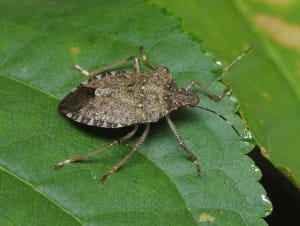The Brown Marmorated Stink Bug: An unwelcome arrival
This week, scientists confirmed that the brown marmorated stink bug (Halyomorpha halys) has been found in the UK.

This week, scientists confirmed that the brown marmorated stink bug (Halyomorpha halys) has been found in the UK. This stink bug, named for the foul smell they release when threatened, is a dangerous invasive species native to China, Japan and Korea. It has been found in Europe since 2004, suspected to have spread from Switzerland, causing major concern as they are considered to wreak economic havoc particularly in the US and Italy.
They consume many fruits and vegetables, including major crops such as apples, pears, tomatoes and sweetcorn. They pierce the surface with their proboscis, suck out the juice and leave unattractive brown marks which makes them less marketable. Their effects on many fruits and vegetables are only aesthetic, as they leave brown spots behind that make the produce unmarketable.
However, their impact on the products of these crops can be disastrous, as in the case of wine. If they end up in the drink, the smell permeates it and has detrimental impacts on the taste. Sometimes the whole crop has to be thrown away. Their diet consists of over 100 agricultural and ornamental flora, meaning a great variety of plants in the UK are at risk. Unfortunately, there are very hard to control as many insecticides fail to function due to their method of piercing fruit and vegetables with their proboscis, and many insecticides that do kill them don’t permanently prevent their return.
They’ll establish pretty quickly, you find one or two and then they are everywhere
Individual stink bugs have been seen in the UK since 2014. The horticultural research organisation NIAM EMR have been attempting to monitor their arrival through traps that involve attracting them with a synthetically produced pheromone and capturing them with sticky plastic. They have since been trapped in the Natural History Museum gardens and the RSPB Rainham Marshes.
Their danger will depend on their numbers. “They’ll establish pretty quickly... You find one or two and then they are everywhere” claimed Max Barclay on invasive species when asked in a Natural History Museum press release. He is the senior curator in charge of Coleoptera at NIAM EMR. He refers back to the last invasive species to make headlines in the UK, the harlequin ladybird from China, which is now incredibly abundant here but has established itself as part of the fauna, with its numbers in decline.
Brown marmorated stink bugs were most likely imported in packaging or crates, as they like to seek shelter, such as warm homes, to hibernate in the winter months. They are expected to become part of the established British fauna in the next few years. Researchers believe that global warming will encourage the bug to inhabit London and parts of eastern England where it is warmest.






